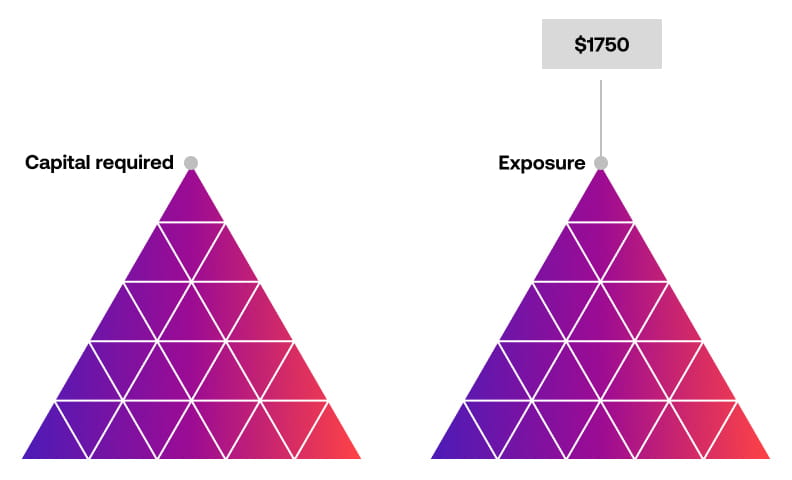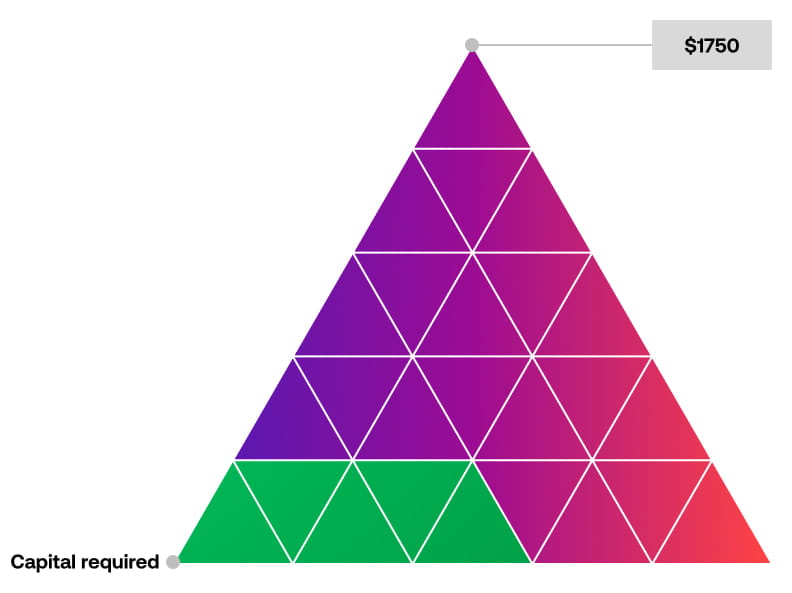
Trading with leverage
An introduction to leverage in trading
You can get larger market exposure for just a small initial deposit when you use a leveraged product. Let’s explore how leverage works, as well as the benefits and risks of using it in your trading.
- What is leverage in trading?
- What is margin in trading?
- Types of leveraged instruments products
- Risks of leveraged trading
- Margin call
What is leverage in trading?
Leverage in trading is a powerful mechanism that you can use to increase your potential returns by using borrowed money to open a position. You’ll put down just a small initial deposit, and your provider is ‘loaning’ you the rest – resulting in larger market exposure relative to your initial deposit. .
Magnified profits sounds great, right? But as with most things, the greater the reward, the greater the risk.
Leverage can result in magnified potential losses, which makes it important for you to understand exactly what you’re getting yourself in for and how to manage the risks involved.
What is margin in trading?
Margin in trading refers to the funds required to open and maintain a leveraged position. The amount needed in your account is expressed as a percentage relative to the net equity and total required margin of your account.
Once you’ve opened a position, you’ll need to keep enough money in your account to cover the margin requirement. The amount you’ll need can change from market to market, but typically the riskier the market or the greater your position, the higher the margin factor.
Example of a leveraged trade
Let’s say you’re interested in buying 10 Apple shares at the current market price of $175.
Normally, you’d pay the full $1,750 to buy the shares via a stockbroker – excluding any commission and other charges. If the shares went up by $5, you’d have $50 profit (5x10) but if they fell by the same amount, you’d have lost $50.

When you trade on margin, you might only have to put down 10% of $1,750 to open the position. So you’d pay $175 to get the full market exposure of $1750.
Your profit and loss are calculated using the total value of the position. If the shares increased by $5, you’d still make $50 and if the shares fell by $5, you’d lose $50.

Types of leveraged products
There are a variety of ways that you can incorporate leverage into your trading strategy. Here are some of the most popular leveraged instruments:
- Contracts for difference (CFDs)
- Futures contracts
- Options contracts
We’ll explore these in more depth in the next few lessons.
Risks of leveraged trading
As we’ve seen, trading on leverage means that you can increase your potential profits. But this also means that you are exposed to more risk if the trade goes against you. Here are a few key things to consider:
Magnified loss
Both your profit and loss are calculated based on the full value of your trade. While your initial outlay is smaller, it’s easy to forget that you’re potentially putting a much larger sum at risk and losses can exceed deposits. You should always consider your trade as a whole, and never risk more than you can afford to lose.
Learn how to manage your risk more effectively.
Margin call
If the value of your asset falls in price, you could get placed on margin call. It’s important to monitor your margin level closely, as you may not receive a notification prior to closure.
At this point, you have three options: close out your position yourself, reduce the size of your trade or add additional funds to your account to cover any losses. If you leave your position and it drops to 50% of the margin requirement, we'll close it automatically.
To make things easier for you, we’ve created the Margin Level Indicator, which represents the level of cover you have for open positions. It’s located along the top of your trading platform. It will display one of these scenarios:
- Sufficient margin
- Your trade is at risk
- Insufficient margin
If the margin level indicator is greater than 100%, then you have the funds on your account required to keep your positions open.
If your margin level indicator falls below 100%, your account will be subject to a margin call. This means that you no longer have the required funds on your account to meet the margin requirement, and you should take action to address this. A warning symbol will also be displayed next to the margin indicator.
Should the margin level indicator fall below 50%, one or more of your open positions will be automatically closed, until the indicator returns above 50%. This is to prevent you from incurring additional losses, and you’ll be notified via email when automatic closeout has occurred.
Funding charges
Remember, when you trade on leverage, you’re basically borrowing money from your provider. This means that if you want to keep your position open, you’ll usually be charged a small fee to cover the costs involved. Think of it like paying interest on a bank loan.
We’ll look at this in more detail later in lesson five, overnight funding explained.






